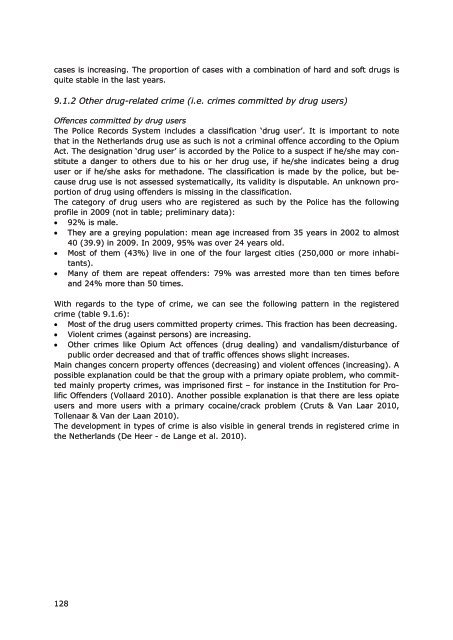The Netherlands Drug Situation 2010 - Trimbos-instituut
The Netherlands Drug Situation 2010 - Trimbos-instituut
The Netherlands Drug Situation 2010 - Trimbos-instituut
Create successful ePaper yourself
Turn your PDF publications into a flip-book with our unique Google optimized e-Paper software.
cases is increasing. <strong>The</strong> proportion of cases with a combination of hard and soft drugs isquite stable in the last years.9.1.2 Other drug-related crime (i.e. crimes committed by drug users)Offences committed by drug users<strong>The</strong> Police Records System includes a classification ‘drug user’. It is important to notethat in the <strong>Netherlands</strong> drug use as such is not a criminal offence according to the OpiumAct. <strong>The</strong> designation ‘drug user’ is accorded by the Police to a suspect if he/she may constitutea danger to others due to his or her drug use, if he/she indicates being a druguser or if he/she asks for methadone. <strong>The</strong> classification is made by the police, but becausedrug use is not assessed systematically, its validity is disputable. An unknown proportionof drug using offenders is missing in the classification.<strong>The</strong> category of drug users who are registered as such by the Police has the followingprofile in 2009 (not in table; preliminary data): 92% is male. <strong>The</strong>y are a greying population: mean age increased from 35 years in 2002 to almost40 (39.9) in 2009. In 2009, 95% was over 24 years old. Most of them (43%) live in one of the four largest cities (250,000 or more inhabitants). Many of them are repeat offenders: 79% was arrested more than ten times beforeand 24% more than 50 times.With regards to the type of crime, we can see the following pattern in the registeredcrime (table 9.1.6): Most of the drug users committed property crimes. This fraction has been decreasing. Violent crimes (against persons) are increasing. Other crimes like Opium Act offences (drug dealing) and vandalism/disturbance ofpublic order decreased and that of traffic offences shows slight increases.Main changes concern property offences (decreasing) and violent offences (increasing). Apossible explanation could be that the group with a primary opiate problem, who committedmainly property crimes, was imprisoned first – for instance in the Institution for ProlificOffenders (Vollaard <strong>2010</strong>). Another possible explanation is that there are less opiateusers and more users with a primary cocaine/crack problem (Cruts & Van Laar <strong>2010</strong>,Tollenaar & Van der Laan <strong>2010</strong>).<strong>The</strong> development in types of crime is also visible in general trends in registered crime inthe <strong>Netherlands</strong> (De Heer - de Lange et al. <strong>2010</strong>).128




